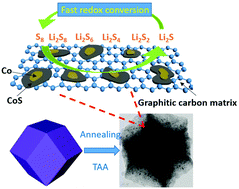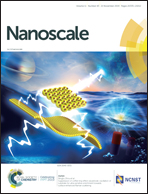In situ grown α-Cos/Co heterostructures on nitrogen doped carbon polyhedra enabling the trapping and reaction-intensification of polysulfides towards high performance lithium sulfur batteries†
Abstract
Lithium sulfur (Li–S) batteries are considered as one of the most promising next generation energy storage systems, whereas their intrinsic drawbacks impeded their practical implementation. Herein, a nitrogen doped porous carbon polyhedron coupled with a well distributed α-CoS/Co heterostructure mediator was designed and prepared as the sulfur cathode host for lithium sulfur batteries. The α-CoS/Co heterostructure on a nitrogen doped carbon polyhedron (NCP) not only provides a strong adsorption interaction towards soluble polysulfides, but more importantly, also promotes the fast conversion of polysulfides to insoluble products, chemically suppressing the shuttling of polysulfides through the simultaneous advantages of α-CoS and Co. As a result, the α-CoS/Co-NCP-S cathode exhibits high sulfur utilization with a 1611.4 mA h g−1 first discharge capacity and a well satisfactory redox cycling stability with a low capacity fade rate of 0.042% per cycle at 0.5 C for over 800 cycles. Moreover, the hybrid cathode delivers 860.2 mA h g−1 specific capacity for a high sulfur loading of 4.8 mg cm−2 with remarkable cycling performance.



 Please wait while we load your content...
Please wait while we load your content...